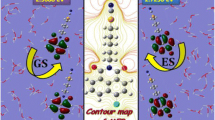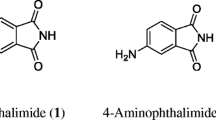Abstract
The Fluorescence spectroscopic and solvatochromic behavior of Sulfisoxazole, a sulfa drug with antimicrobial activities, in various pure solvents of different polarity and hydrogen bonding capability is reported. The fluorescence emission spectrum of sulfisoxazole was found to be solvent polarity dependent, where a notable red shift in emission maximum was observed with increasing solvent polarity as well as hydrogen bonding capability. The effects of the latter two solvent parameters were quantitatively investigated using the methods of Lippert–Mataga and solvatochromic comparison method (SCM) that is based on the Kamlet-Taft equation. Particularly, the Lippert–Mataga method was applied to estimate the dipole moment of the excited state (μe) upon plotting Stokes shift versus solvent polarizability (Δf), where a value of 11.54 Debye was obtained. On the other hand, applying the multiple regression analysis to the SCM method revealed that solvent polarizability (π*) and hydrogen-bond donor capability (α) approximately equally stabilize sulfisoxazole in the excited state with minor destabilization contribution by the hydrogen-bond acceptor capability (β). These findings revealed that the excited state of sulfisoxazole is stabilized by polar solvents, indicating that this drug molecules exhibit larger dipole moment in the excited state than in the ground state, which in turn implies that a potential intramolecular charge transfer (ICT) occurs after excitation.







Similar content being viewed by others
References
Lakowicz JR (2006) Principles of fluorescence spectroscopy, 3rd edn. Kluwer Academic/Plenum Press, New York
Garbowski Z, Rorkiewicz K, Rettig W (2003) Structural changes accompanying intramolecular electron transfer: focus on twisted intramolecular charge-transfer states and structures. Chem Rev 103:3899–4032
Rohatgi-Mukherjee KK (1992) Fundamentals of photochemistry. Wiley Eastern, New Delhi
Quintero B, Miranda M (2000) Mechanisms of photosensitization induced by drugs: a general survey. Ars Pharmaceutica 41(1):27–46
Hans R, Agrawal N, Verma K, Misra R, Ray A, Farooq M (2008) Assessment of the phototoxic potential of cosmetic products. Food Chem Toxicol 46:1653–1658
Serrano-Perez J, Serrano-Andres L, Merchan M (2008) Photosensitization and phototherapy with furocoumarins: a quantum-chemical study. Chem Phys 347:422–435
Musa K, Eriksson L (2009) Photochemical and photophysical properties, and photodegradation mechanism, of the non-steroid anti-inflammatory drug Flurbiprofen. J Photochem Photobiol A Chem 202(1):48–56
Arantes F, Barbosa L, Alvarenga E, Demuner A, Bezzera D, Ferreira J, Costa-Lotufo L, Pessoa C, Moraes M (2009) Synthesis and cytotoxic activity of α-santonin derivatives. Eur J Med Chem 44(9):3739–3745
Davids L, Klemann M, Kacerovska D, Pizinger K, Kidson S (2009) New aspects in photodynamic therapy of actinic keratoses. J Photochem Photobiol B Biol 96(3):159–169
Smits T, Moor A (2008) Hypericin phototoxicity induces different modes of cell death in melanoma and human skin cells. J Photochem Photobiol B Biol 91(2–3):67–76
Kushibiki T, Sakai M, Awazu K (2009) Differential effects of photodynamic therapy on morphologically distinct tumor cells derived from a single precursor cell. Cancer Lett 268(2):244–251
Jimenez-Banzo A, Sagrista ML, Mora M, Nonell S (2008) Kinetics of singlet oxygen photosensitization in human skin fibroblasts. Free Radic Biol Med 44(11):1926–1934
Zupan K, Egyki M, Toth K, Fekete A, Herenyi L, Modos K, Csik G (2008) Comparison of the efficiency and the specificity of DNA-bound and free cationic porphyrin in photodynamic virus inactivation. J Photochem Photobiol B Biol 90(2):105–112
Daryany M, Hosseini S, Raie M, Fakharie J, Zarehv A (2008) Study on continuous (254 nm) and pulsed UV (266 and 355 nm) lights on BVD virus inactivation and its effects on biological properties of fetal bovine serum. J Photochem Photobiol B Biol 92(2):120–124
Pal SK, Zewail AH (2004) Dynamics of water in biological recognition. Chem Rev 104:2099–2124
Bilski P, Martinez LJ, Koker EB, Chignell CF (1998) Influence of solvent polarity and proticity on the photochemical properties of norfloxacin. Photochem Photobiol 68(1):20–24
Plášek J, Hošková B (2010) Solvatochromic effect in the optical spectra of calcofluor and its relation to fluorescent staining of yeast cell walls. J Fluoresc 20(1):343–352
Garcıa C, Oyola R, Pinero L, Hernandez D, Arce R (2008) Photophysics and photochemistry of imipramine, desimipramine, and clomipramine in several solvents: a fluorescence, 266 nm laser flash, and theoretical study. J Phys Chem B 112:168–178
Park H-R, Oh C-H, Lee H-C, Lim SR, Yang K, Bark K-M (2004) Spectroscopic properties of various quinolone antibiotics in aqueous—organic solvent mixtures. Photochem Photobiol 80(3):554–564
Posokhov Y, Biner H, Içli S (2003) Spectral-luminescent and solvatochromic properties of anticancer drug camptothecin. J Photochem Photobiol A Chem 158(1):13–20
Park KK, Park JW, Hamilton AD (2007) Solvent and pH effects on the fluorescence of 7-(Dimethylamino)-2-Fluorenesulfonate. J Fluoresc 17(4):361–3369
Umadevi M, Vanelle P, Terme T, Rajkumar BJM, Ramakrishnan V (2008) Spectral investigations of solvatochromism and preferential solvation on 1, 4-dihydroxy-2, 3-dimethyl-9, 10-Anthraquinone. J Fluoresc 18(6):1139–1149
Liu H-B, Yu D, Shin SC, Park H-R, Park JK, Bark K-M (2009) Spectroscopic properties of quercetin derivatives, quercetin-3-O-rhamnoside and quercetin-3-O-rutinoside, in hydro-organic mixed solvents. Photochem Photobiol 85(4):934–942
Connor EE (1998) Sulfonamide antibiotics. Prim Care Update Ob Gyns 5:32–35
Brackett CC, Singh H, Block JH (2004) Likelihood and mechanisms of cross-allergenicity between sulfonamide antibiotics and other drugs containing a sulfonamide functional group. Pharmacotherapy 24:856–870
Supuran CT, Casini A, Scozzafava A (2003) Protease inhibitors of the sulfonamide type: anticancer, antiinflammatory, and antiviral agents. Med Res Rev 23:535–558
Kim J, Park Y, Choi K (2009) Phototoxicity and oxidative stress responses in Daphnia magna under exposure to sulfathiazole and environmental level ultraviolet B irradiation. Aquat Toxicol 91(1):87–94
de Liguoro M, Fioretto B, Poltronieri C, Gallina G (2009) The toxicity of sulfamethazine to Daphnia magna and its additivity to other veterinary sulfonamides and trimethoprim. Chemosphere 75:1519–1524
Reichardt C (1994) Solvatochromic dyes as solvent polarity indicators. Chem Rev 94:2319–2358
Kamlet MJ, Abboud J-LM, Abraham MH, Taft RW (1983) Linear solvation energy relationships. 23. A comprehensive collection of the solvatochromic parameters, pi.*, alpha., and.beta., and some methods for simplifying the generalized solvatochromic equation. J Org Chem 48:2877–2887
Author information
Authors and Affiliations
Corresponding author
Rights and permissions
About this article
Cite this article
Bani-Yaseen, A.D. Solvatochromic and Fluorescence Behavior of Sulfisoxazole. J Fluoresc 21, 1061–1067 (2011). https://doi.org/10.1007/s10895-010-0778-y
Received:
Accepted:
Published:
Issue Date:
DOI: https://doi.org/10.1007/s10895-010-0778-y




